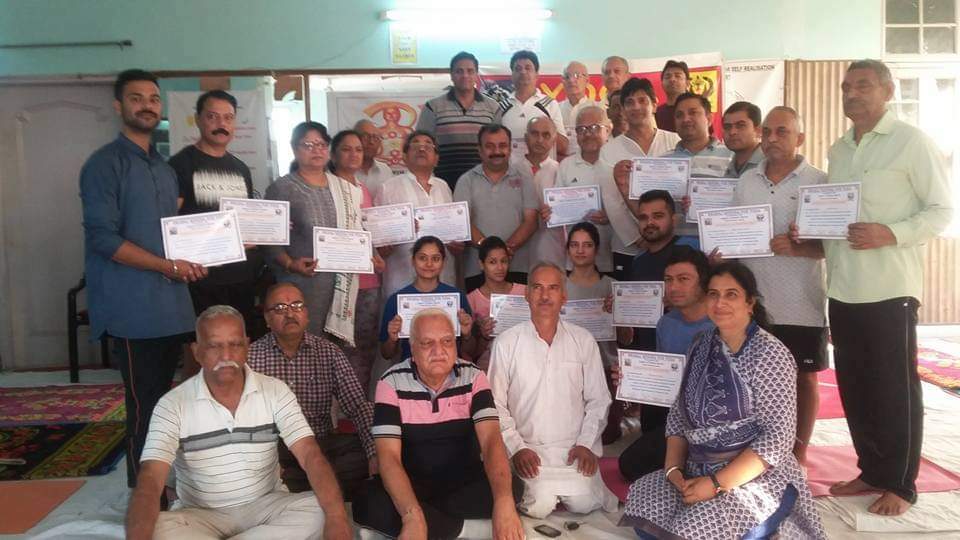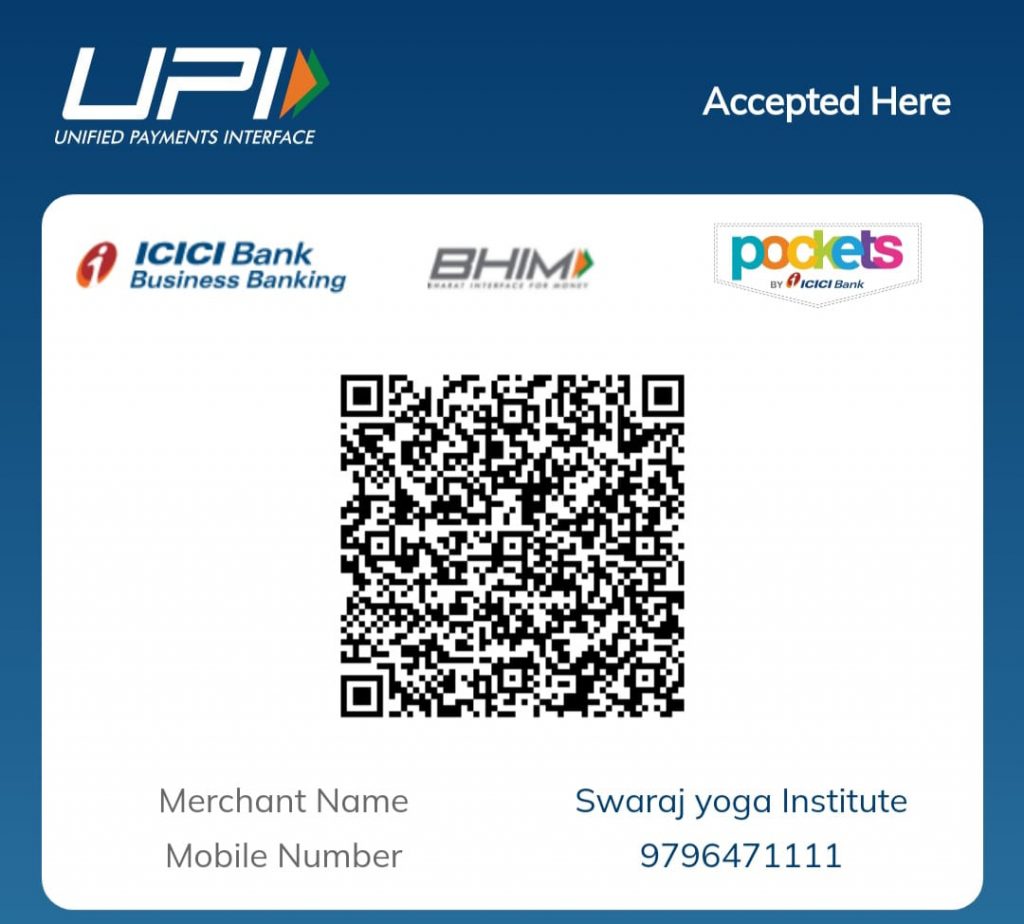

As we progress in our Yogic journey, a desire arises to learn advance yogic practices and techniques. This training course will help you establish your sadhana (practice) and make you a better learner to impart the same to many more. Find out more about this advanced-level teacher’s course in yoga.
JOB Avenues -Certified Yoga Teacher becomes eligible to teach Yoga for prevention of illness and promotion of wellness in schools, Yoga studios, workplaces, Yoga wellness centres, Health Resorts etc.
Eligibility – 12th Std or Certificate Course in Yoga
Duration – One Year ( 500 Hrs ) – Classes on weekend only
Practical: Theory = 50 : 50 I.E. 250 Hours: 250 Hours
Minimum Contact Hours = 80% I.E. 400 Hours
Practical – Total Contact Hours = 200 Hours
Theory – Total Contact Hours = 200 Hours
Discounted Price for Indian students only
Course Fee – offline or online mode (INR): 30000 INR only for Indian students
( Course not available to foreigners )
Maximum group size: 10 /12
Class Schedule – Saturday / Sunday — online only or mix of online + Offline Class – Total 10+ – Hrs in two days ( 2.5 hr offline , morning or online – 2.5 hr evening online )
Scholarship for Needy Students – Scholarship and Rebates are available for poor/needy intelligent candidates but deserving only subject to a written/Practical test on Yoga and an interview cleared as per management rules .A separate written request can be submitted with a special note ( Max 200 words )to [email protected] .
Highlights
- One Year Yoga Course- Online and Offline modules
- Live sessions by a certified professional faculty
- Available for national students
- Accommodation available for international and national students
- Learn while enjoying a natural living experience of the yogic lifestyle
- Live online sessions will be held over Zoom, Google Duo or Microsoft Teams
- For Online sessions’ time zone: Dharamshala, India (India Standard Time, GMT 5.5)
- English instruction. Hindi English .
- Course can start as soon as you sign up
- Self-paced is possible upon discussion with the teacher
- Internship- A practical exposure to teach as Yoga Instructor – All candidates are given an opportunity to hold Yoga Classes as Instructor in our Campus Yoga classes to make participants have full confidence in their capabilities as Yoga Instructor
Yoga styles
- Hatha Yoga
- Traditional Yoga
- Ashtanga Yoga
- Special sessions on Kurunta (Rope)Yoga (inspired By Iyengar )
What’s not included
- Yoga books( But available on nominal price cost to cost )
- Yoga Certification Board (Govt. of India) Yoga Exam fees
Cancellation/Refund Policy
- A Booking / reservation requires a deposit of minimum 50% of the total price as per courseoptions opted . Remaining payable before joining the class .
- For cancelling the registration before the start of the course, the original payment will be refunded less:
15 % ie. INR payments of the payment made – any time after booking until three months
25 % after 3 Months to the start of course date
Refund after Joining the course – If student leaves within 3 days after joining the class The course fee mentioned without stay and food option will not be refunded for reason whatsoever. Where as other amount paid for food and stay shall be paid back as per the days stayed as per total package cost with in 3 days . After 3 days of joining – The whole amount deposited is non-refundable .
Full refund will only be granted where SYIWR has had to cancel the programme.
Start Dates : Self Paced ( Separate Dates can be offered subject to availability – Drop separate request email on [email protected] )
Theory syllabus
| Section 1 Philosophy | Detailed understanding of: |
| Indian Philosophy | 59. What is Karma Yoga? |
| 1. Astika & Nastika Darsanas | 60. What is Bhakti Yoga? |
| 2. Common Characteristics of IP (a slightly deeper understanding) | 61. What is Jnana Yoga? |
| Samkhya Darshana | Upanishads |
| 3. Dukha Traya | 62. Meaning of ‘Upanishad’ |
| 4. Purusa & Prakrti | 63. Names of 10 Main Upanishads |
| 5. Avidya | 64. A few Upanishadic doctrines – 4 Mahavakyas |
| 6. Tri–Guna Theory | 65. Panchamaya (Pancha kosha) theory |
| 7. Names and Characteristics of 25 Tattvas | Vedas |
| 8. Kaivalya | 66. Meaning of ‘Veda’ |
| Yoga Darshana (Patanjali Yoga Sutras) | 67. Names of 4 Vedas |
| 9. Background of Patanjali | 68. Four parts of each Veda, Veda Angas & Upa Vedas |
| 10. Names of 4 Padas | Puranas |
| 11. The Ashtangas | 69. Name of Author |
| 12. Sabija / Nirbija / Dharmamegha Samadhi | 70. Basic understanding of Puranas |
| 13. Antarayas and method to remove them | 71. Names of 18 Puranas |
| 14. Vikshepa Sahabhuvas and method to remove them | 72. Purushartha theory |
| 15. Vrittis & methods to eliminate them | Section 3A Anatomy & Physiology: Medical Science & Yoga |
| 16. Klesas & methods to eliminate them | A. Anatomy & Physiology as per Medical Science |
| 17. Cittaprasadana & Manasthithi Nibandhini techniques | 73. Names of 9 Main Systems and Organs in each system |
| 18. Definition & description of Ishvara | 74. Other Main Organs (e.g. Eyes, Ears, etc.) |
| 19. Concept of Samapatti | 75. Main Functions of above |
| 20. Concept and examples of Siddhis / Vibhutis | 76. Effects of Yoga Practices on the above systems and organs. |
| 21. Kaivalya | B. Yogic Anatomy & Physiology as per Yoga |
| Etymological Meanings & Definitions of ‘Yoga’ | 77. Concept of Prana |
| Meanings with Explanation | 78. Names and Functions of the Pancha Pranas and Upa Pranas |
| 22. Yujir-yoge | 79. Concept of Nadi & names of Nadis |
| 23. Yuj-samyoga | 80. Significance of Ida, Pingala & Sushumna Nadis |
| 24. Yuj-samyamne Yuj-samadhi | 81. Ashta Chakras and their Significance |
| Definitions with Explanation | 82. Names of Granthis & Chakra awakening |
| 25. PYS Def Ch I – S: 2 | 83. Names of Endocrine glands corresponding to Chakras |
| Bhagavad Gita | 84. Kundalini & its awakening and practices (e.g. Bandhas, Shaktichalana Mudra, etc.) for same |
| 26. Samatvam Yoga Uchyate; | Section 3B Human Psychology as per Yoga |
| 27. Yogaha Karmasu Kaushalam | Personality theories |
| Salient features of Indian Culture | 85. Deeper understanding personality according to Tri- Gunas |
| Only Names & brief understanding | 86. The 5 Citta Bhumis & their Guna orientation |
| 28. Deeper Understanding | 87. Understanding of Personality as per Samkhya Darsana: Prakrti (Sthula, Sukshma & Karana Shariras) + Purusa |
| 29. Sanatana Dharma | 88. Panchamaya (Panchakosha) theory as already considered in earlier section |
| 30. Vaidic Dharma | Concept of Mind |
| 31. Anekantavada | 89. Names & functions of elements of Antahkarana in Samkhya: Buddhi, Ahamkar & Manas. |
| 32. Ashrama Dharma | 90. Concept of Citta in PYS |
| 33. Purusharthas | 91. Distractions / Disturbances of Mind – 9 Antarayas as per PYS, Shad Ripu as per Upanishads (Kama, Krodha, Lobha, Moha, Mada & Matsarya), Samskaras (conditioning) / Vasanas /Klesas, etc. |
| 34. Guru-Shishya Parampara | 92. Mind Control Techniques: Yamas, Niyamas, Pranayama, Meditation, Pranavajapa, Ek Tattva abhyasa, Cittaprasadana techniques, Pratipaksha Bhavana, Relaxation Practices (Shavasana, Yoga Nidra, etc.) |
| 35. Karma & Law of Karma | Life Style Considerations |
| 36. Dharma | 93. Diet: Mitahar as per HP; |
| 37. Spiritual culture (Adhyatmic Samskriti) / Materialistic culture (Bhautic Samskriti) | 94. Bhagavad Gita: Diet, rest, relaxation, exertion, etc |
| Section 2 Basic Texts of Yoga | 95. Elaboration of Yogic Life style |
| Patanjali Yoga Sutras | Introduction to Ayurveda |
| 38. Over-view of 1st and 2nd Padas | 96. Meaning of ‘Ayurveda’ |
| 39. Over-view of 3rd and 4th Padas | 97. 3 Doshas |
| 40. Sutras by heart | 98. Concepts of Health (Swasthya), Mala; Dhatus; etc. |
| 41. Definition (Ch:I S-2); | Section 4 Teaching of Yoga |
| 42. Ashtanga Yoga (Ch:II S- 29); | 99. Teaching Methods (Instruction; Observation; Demonstration; Correction) |
| 43. Asana (Ch:II S-46); | 100. Teaching Aids |
| 44. Pranayama (Ch:II S-49) | 101. Communication Skills |
| 45. Ashtangas of Yoga (Ch:II S-54) (Ch:III S-1, 2 &3) | 102. Verbal & Non-verbal |
| 46. Cittaprasadana (Ch:I S-33 &34) | 103. Ideal Qualities of Teacher |
| 47. Pratipaksha Bhavana (Ch:II S-33) | 104. Conducive Environment |
| Hatha Pradipika (HP) & Gheranda Samhita (GS) | 105. Safety measures |
| 48. Deeper Understanding of Hatha Yoga | 106. Guideline as regards framework of Professional Practice |
| Deeper understanding of Hatha Pradipika | |
| 49. Understanding of 4 angas | |
| 50. Understanding of 15 Asanas | |
| 51. Understanding of Shat Kriyas | |
| 52. Understanding of 8 | |
| 53. Kumbhakas | |
| 54. Understanding of 10 Mudras | |
| 55. Badhak Tattva / Sadhak Tattva | |
| Deeper understanding of Gheranda Samhita | |
| 56. Understanding of Saptangas | |
| Bhagavad Gita | |
| 57. Name of Author | |
| 58. No. of Chapters |
Practical Syllabus
| Section 1 SukshmaVyayama / Preparatory Practices / Sandhi Chalana kriya | Two Inverted Asanas |
| 1. Institution-specific | 45. Sarvangasana |
| Section 2 Shuddhi Kriyas | 46. Shirsasana |
| 2. Dhauti: VamanDhauti; Danda Dhauti; Vastra Dhauti; Agnisaar | Section 4 Suryanamaskar |
| 3. Neti: Jal Neti; Sutra Neti | 47. Suryanamaskar (Traditional with 12 Poses and accompanying 48. Mantras) (Can be School- Specific) |
| 4. Tratak | Section 5 Pranayama |
| 5. Kapalbhati | 48. Sectional Breathing |
| 6. Nauli | 49.Yogic Breathing |
| 7. Theoretical Knowledge as regards Basti | 50. Nadishodhana |
| Section 3 Asanas | Kumbhakas with Bandhas |
| Five Meditative Asanas | 51. Suryabhedana |
| 8. Siddhasana | 52. Ujjayi |
| 9. Padmasana | 53. Shitkari |
| 10. Svastikasana | 54. Shitali |
| 11. Vajrasana | 55. Bhramari |
| 12. Veerasana | 56. Bhastrika |
| Seven Standing Asanas | 57. Sagarbha & Agarbha Nadishodhana Pranayama |
| 13. Tadasana | Bandhas |
| 14. Ekpadasana | 58. Mulabandha |
| 15. Vrikshasana | 59. Uddiyana Bandha |
| 16. Utkatasana | 60. Jalandhar Bandha |
| 17. Trikonasana | 61. Jivha Bandha |
| 18. Padahastasana | 62. Maha bandha |
| 19. Garudasana | Section 6 Mudras |
| Five Kneeling Asanas | 63. Chin / Jnana Mudra |
| 20. Ushtrasana | 64. Padma Mudra |
| 21. Marjarasana | 65. Agochari Mudra (Nasikagra Drishthi) |
| 22. Vyahgrasana | 66. Shambhavi (Bruhmadhya Drishthi) |
| 23. Shashankhasana | 67. Viparitakarani |
| 24. Supta vajrasana | 68. Khechari |
| Eight Sitting Asanas | 69. Mahamudra |
| 25. Bhadrasana | 70. Mahavedha Mudra |
| 26. Simhasana | 71. Ashvini Mudra |
| 27. Gaumukhasana | 72. Yoga Mudra |
| 28. Vakrasana | 73. Shanmukhi Mudra |
| 29. Parvatasana | 74. Shaktichalana Mudra |
| 30. Paschimottanasana | 75. Brahma Mudra |
| 31. Matsyendrasana | Section 7 Mantras |
| 32. Ardhamatsyendrasana | 76. Pranava japa |
| Five Prone Asanas | 77. Shanti Mantra: Can be institution-specific |
| 33. Bhujangasana | Section 8 Meditation |
| 34. Shalabhasana | 78. Swaraj Heart purification |
| 35. Dhanurasana | Section 9 Teaching Practice |
| 36. Naukasana | 79.Institution-specific |
| 37. Makarasana | |
| Seven Supine Asanas | |
| 38. Pavanmuktasana | |
| 39. Setubandhasana | |
| 40. Matsyasana | |
| 41. Uthitapadahastasana | |
| 42. Halasana | |
| 43. Chakrasana | |
| 44. Shavasana |

For International Students
ICICI Bank limited
Swaraj yoga Institute and Wellness Retreats
Current account no
104105001096
IFSC code
ICIC0001041
Swift code: ICICINBBNRI
